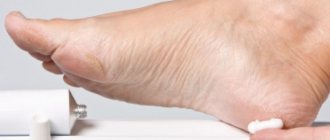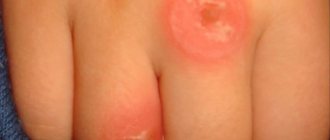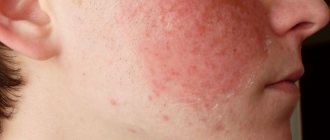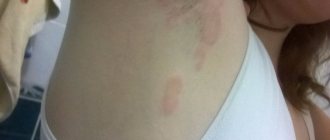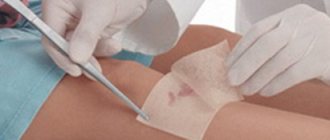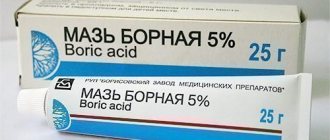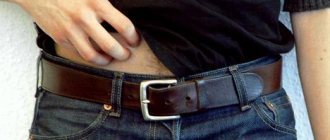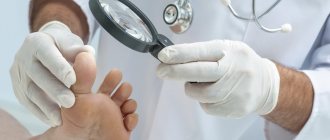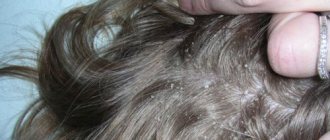Home » Traditional recipes
Folk recipes
Author Maria Khorolets Reading time: 8 min. Views 12k. Published 09.09.2015
Dry callus is a very common problem. As a rule, it occurs on the heel or sole of the foot, causing a lot of discomfort when walking. Many have learned to solve this problem in a very unconventional way, by placing special insoles in their shoes with a hole cut out for the callus or cotton wool. However, this does not eliminate the problem itself, but, on the contrary, strengthens it. Therefore, today we propose to talk about how you can use proven folk remedies to quickly and effectively get rid of any types of dry calluses, forgetting about constant discomfort.
- Types of dry calluses
- Treatment options
Herbal remedies
- Therapeutic baths for dry calluses with a rod
- Homemade ointments
- Other means
Development of calluses with a core
First, as a result of the long-term action of one or several pathological factors, wet calluses form on damaged areas of the skin with their gradual transformation into dry calluses, which, if treated incorrectly or untimely, begin to grow deep into the tissue and transform into internal or core calluses.
These formations are difficult to treat, and problems of an aesthetic nature are complemented by severe pain when walking, which changes gait, leading to improper load on the knee, ankle and small joints of the foot (depending on the location of the callus), which leads to the development of inflammatory and degenerative diseases in them. processes (arthrosis and arthritis). Also, these painful formations have a tendency to periodic inflammation, so they need timely and adequate treatment.
The process of getting rid of calluses often takes a long time, but the only way to cure them is to completely remove them using various methods.
Features of treatment
Treatment of callus is quite difficult and time-consuming. All this is a consequence of the fact that the root of such a callus goes quite deep. Simply cutting off the top of the callus will not work. Since, if the central part (the shaft) is not completely removed, then in 95% of cases the callus appears again.
Indications for removal
There are certain indications for callus removal, these include:
- bruising around the callus;
- cracks;
- severe pain while walking;
- severe pain when moving your arms;
- development of the inflammatory process;
- changes in color, swelling.
After a complete examination, the doctor prescribes treatment. Thus, treatment can be prescribed in the form of drilling with a drill. The callus is drilled out with a special medical device.
The keratinized areas are removed with special cutters. The procedure takes place without painkillers. After the procedure, the skin is restored within 3-4 days. This procedure has many disadvantages:
- repeating the procedure is often required;
- undamaged areas of the skin are affected;
- possible infection.
Removing callus with a milling cutter. Hardware pedicure
Cryodestruction of callus with rod
This procedure is based on exposing the callus to fairly low temperatures. Liquid nitrogen is used for this. One procedure is enough, which generally lasts no more than 4-5 minutes, during which the central rod is completely destroyed. The callus turns white, and a bubble begins to form at the site of nitrogen exposure. Which gradually dissolves. The procedure does not require special anesthesia. The skin is completely restored within two weeks. In this case, scars do not remain on the skin.
There are a number of disadvantages of cryodestruction:
- with severe ingrowth it is considered an ineffective procedure;
- no regulation of the depth of exposure;
- high risk of re-infection.
Laser callus removal with rod
One of the most effective and common methods of treating calluses is laser removal. The laser is capable of affecting the callus quite deeply, without giving the rod a chance to “survive”. The procedure lasts on average up to 10 minutes. The callus, after exposure to the laser, gradually becomes covered with a crust and after two weeks the crust disappears on its own. At the same time, it is strictly forbidden to touch the calluses or try to rip them off yourself. This treatment method has a huge range of advantages:
- treats neglected (old) calluses;
- does not damage adjacent healthy areas of skin;
- it is possible to adjust the depth of exposure;
- no bleeding occurs;
- fairly low risk of infection;
- One procedure is sufficient for treatment.
Radio wave method
The method is based on exposure of the callus to high-frequency radio wave electrodes. For this, the Surgitron apparatus is used. It affects only the affected areas of the skin, without affecting healthy tissue. This treatment method is quite highly effective. There are many advantages:
- the procedure is painless;
- healthy (adjacent) skin areas are not affected;
- there is no bleeding;
- fast healing;
- Oncology testing is possible.
Drug treatment method
This treatment method is quite lengthy. It should absolutely not be confused with treatment that uses a callus plaster. To completely destroy the central core, it is necessary to use substances with a keratolytic effect to loosen and remove dead skin cells. For this, salicylic acid is used, plus other components are added that provide antiseptics and prevent anti-inflammatory processes.
This treatment has a number of nuances:
- Medicines containing acid can cause burns and irritation. That is why it is necessary to apply medications only directly to the affected area of the skin.
- Do not use if you have moles, ulcers, or minor wounds.
- Treatment very often leads to swelling of the skin, itching, dermatitis, and allergic reactions.
Treatment depending on the location of occurrence
If the callus has formed on different parts of the foot, then different treatments must be prescribed.
On the little toe
To avoid spreading the fungus and infecting another area, consult a dermatologist. Salicylic acid-based medications are often prescribed and applied to the problem area to avoid irritation to healthy skin. Modern methods of rod removal that use laser, hardware, and cryodestruction are also effective.
On the heel
A callus on the heel can be removed using three procedures:
- drilling - using a cutter, the keratinized skin is removed and an antifungal agent is applied, after 3 days all discomfort disappears;
- laser treatment - more often used for advanced stages, the laser burns the rod and destroys bacteria that have accumulated around;
- cryodestruction - burned with liquid nitrogen.
In the early stages, you can purchase the Salipod patch. To use, wash your heel thoroughly and dry it, attach the patch (exclusively to the keratinized area), wear it for 3 days, then remove it, steam your foot and pull out the rod. Treat the hole with iodine and apply an adhesive plaster.
Between the toes
Removing a callus is a complex process, especially between the fingers. At home, you can only remove the top, but the root will probably remain. Therefore, treatment should be carried out by a dermatologist or a qualified pedicurist. The operation is virtually painless; in some cases, more than one visit is required. A special apparatus is used to drill the rod and apply an antiviral or antifungal agent. Or you can use the methods of cryotherapy and laser therapy, in both cases the removal is quick, destroying all microbes.
On a finger
There are several methods to get rid of a callus on your finger:
- folk remedies (steam the callus before going to bed, put garlic on a bandage and secure with a band-aid, remove the bandage in the morning);
- mechanically (steam in a bath with sea salt, treat the keratinized area with pumice and soften with olive or linseed oil);
- medications (use of Condilin, Collomac solutions and creams based on petroleum jelly, salicylic acid and natural oils);
- using a hardware method (cutting the callus using a milling cutter or removing it with a laser).
The child has
You should not immediately start treating a child’s callus at home; it may be corns. A dermatologist will help you figure this out. If it turns out to be a core callus, it can be treated with folk remedies at an early stage. Depending on the age of the child, an effective method will be selected; ointments and callus fluid may also be prescribed. For deep cores, laser therapy cannot be avoided. This is a gentle way to remove a callus with a low probability of its reoccurrence.
What not to do
Dermatologists do not recommend using pumice . It can only worsen the situation, as it contributes to additional trauma to the skin.
Be sure to read:
Tactics for treating inguinal athlete's foot in men
You can't cut off the skin on your fingers , especially if you have problems with the circulatory system.
Doctors advise immediately getting rid of uncomfortable shoes that caused the appearance of corns.
During treatment, you should wear only comfortable shoes or sneakers with orthopedic insoles. After recovery, the patient must carefully choose his shoes.
How to get rid of peeling skin on the palms of your hands? Read the link.
Medications for removing calluses
Pharmacological preparations based on “light” acids effectively soften dry calluses, after which they can be easily removed.
Salicylic, lactic acid
Preparations based on salicylic acid:
- Salicylic ointment
- Collomak
- Nezosol
- Agave
- Callus
The above drugs are available in the form of a cream or ointment, which makes their local use convenient. The product is applied to problem areas and fixed for a certain time. Afterwards, the softened skin is removed.
Note! Callus removers should not be applied to chapped skin or healthy areas. This can lead to chemical burns, the formation of non-healing wounds, and erysipelas.
The pharmaceutical industry offers a Salipod patch, which can be cut to the size of the formation and fixed. After a few days, the callus will come off along with the patch. for old formations, the procedure should be repeated several times.
A drug based on lactic acid – Super Antimozolin. It works in a similar way.
Alkali-based preparations
The pharmaceutical product Superpurity has nothing in common with the herb of the same name. The drug is a mixture of caustic alkalis of sodium and potassium, it is very aggressive and requires special care when used. Removes dry calluses effectively. Using an applicator, apply a drop of the product to the keratinized skin, steam it in water and remove the softened callus.
Antipapillom gel is safer. It is applied pointwise until the formation is completely removed.
Phenol-based preparations
The drugs Condilin and Verrukacid are positioned as means for removing papillomas. However, their necrotizing properties are excellent for removing dry calluses and calluses with a core. Medicines should be applied with the obligatory protection of healthy skin, which is problematic to do on your own on the inside of the toes. An assistant will be needed here.
Condylin or Verrucacid is applied to the formation several times until completely dry. Treatment is repeated until the keratinized skin or callus core disappears.
Treatment with home remedies
Home remedies to remove dry calluses include:
- Solutions of malic and acetic acids. Their action is similar to salicylic acid preparations
- Grated garlic. The paste is applied to the callus and left overnight. The method is more suitable for removing corns on the feet. It is difficult to secure the bandage accurately on the fingers. You can burn healthy skin
- Vegetable oil. Used to soften keratinized areas. For the same purpose, you can apply slices of lard at night.
- Steaming your feet in a soda bath to soften and gradually remove calluses.
Note! It is strictly forbidden to cut the callus with a blade, which is often practiced. Cutting the skin leads to a change in the skin pattern, and the callus grows inward, forming a core that is very difficult to remove.
Removal in a clinic
You can remove dry callus by contacting the clinic. Here will be held:
- Medical pedicure, which will remove all dead skin
- Laser evaporation of calluses. Gradually, layer by layer, the formation is evaporated, leaving no trace of the rod. The procedure is painless and does not require prior preparation.
- Cryotherapy – removal with liquid nitrogen. The keratinized tissue is frozen until completely removed.
Note! Hardware removal of dry calluses is an effective and safe procedure that can be performed both in a medical facility and in a cosmetology clinic. However, without eliminating the cause of callus formation, relapse is inevitable.
Causes of calluses on fingers
The reasons leading to the appearance of calluses on the fingers can often be divided into two groups:
- internal - the most common internal cause is vitamin A deficiency, which is responsible for the health of the skin.
- External – the main external cause of calluses is regular mechanical impact on certain areas of the skin. As a result, the area subjected to rubbing or pressure develops a specific protective reaction - a callus appears.
The location of the formation of calluses on the fingers often depends on the type of activity of the person, and by the location of the calluses on the hands of the interlocutor, one can often determine his profession or hobbies no worse than the famous detective Sherlock Holmes:
calluses appear on the joints, including at the base of the fingers or on the knuckles, in athletes who use equipment such as a horizontal bar, dumbbells, and barbell without gloves.
Also, the bends of the fingers become chafed as a result of constantly carrying bags and packages in their hands, which is typical for many women, especially housewives. Calluses on the pads of the fingers often occur in two categories of the population.
The first group includes people who are often in contact with a computer keyboard for a long time: writers, copywriters, secretaries, office workers, students.
The second group are musicians, especially guitarists. Constant exposure to hard strings leads to gradual keratinization of the skin of the fingertips, and it is musicians who often benefit from dry calluses, protecting the skin from further chafing.
- Calluses on the thumb occur among packers whose monotonous work involves the thumbs being constantly subjected to chafing.
- Calluses on the index finger.
They indicate that their owner writes a lot by hand. They are found in schoolchildren, students, and teachers.Pens and pencils can rub the base and pad of your index finger. A callus at the base of the middle finger is a hallmark of athletes.
Using various utensils with handles, and cooks constantly wielding a knife.
These dry calluses often benefit athletes, such as tennis players, by protecting the hand from the impact of the handle.
Below are photos of calluses on the thumb and index finger of the right hand.
Effective ointments
The Healer is a good remedy for dry calluses on the feet. Essential oils, celandine and oak bark provide a softening effect on the skin. The roughened formation will become smaller after two to three days if the ointment is applied morning and evening. Cost 50 ml 95−110 rubles.
Salicylic. Contains two active substances - an acid with the same name and a keratonic, which promote deep penetration of the drug, improve blood circulation and have a bactericidal effect. The course of treatment lasts 21 days. Contraindications include childhood and kidney and liver diseases. Price from 45 rubles.
Bensalitin copes with long-standing growths and can also be used on blood blisters. The composition contains a keratolytic substance that can remain in the epidermis for a long time. The ointment quickly eliminates the inflammatory process and disinfects.
Ichthyol - ointment for calluses on the toes. Quickly heals wounds and does not cause adverse reactions, allowed for children. Directions for use: apply to a sterile bandage and apply to the formation. You can purchase from 85 rubles.
Zinc is an excellent helper for dry corns. Quickly eliminates inflammation and irritation, dries wet wounds. It must be applied three times a day. Price 25−40 rubles.
Levomekol. Used when there is an infection, it helps restore the dermis. The cost of 10 g is 110 rubles.
Vishnevsky. A well-known medicine with antiseptic and anti-inflammatory effects. Dries wounds well. Has an unpleasant odor. Price from 40−50 rubles per 30 g.
Heparin is a local antibiotic. Contraindicated for use in pregnant women, pregnant women and young children. You can buy from 40 rubles.
Solcoseryl in the form of an ointment saturates the epithelium with oxygen, accelerates cell division, heals and restores tissue. The drug is not cheap, the price ranges from 445 to 1240 rubles.
A medicine for corns from Agafya - an ointment for healing calluses on the feet. The composition contains iodine grass and plantain, as well as other medicinal herbs. Price 60−70 rubles per 75 ml.
Diagnosis and treatment
It is not recommended to independently treat calluses on the little finger. Despite the fact that most tumors do appear due to uncomfortable shoes, it is better to consult a doctor to rule out other pathological factors.
Diagnostics is carried out in several stages:
- Taking an anamnesis: the doctor asks the patient how long ago the callus appeared, what lifestyle the patient leads, and what additional symptoms are observed.
- Initial examination: the doctor determines the general condition of the skin, determines the type of callus and the degree of its pain.
- Additional examinations: if there is a need to determine the presence of infection, a scraping is taken from the callus. To determine the fungus, a Wood's lamp is used, and general tests are prescribed to exclude hidden pathologies.
How to remove it from pharmaceutical products?
Based on the data obtained, treatment is prescribed to the patient. Therapy depends on the type of tumor and its neglect.
- To remove dry calluses or corns, place the foot in warm water for 10 minutes. The rough skin is carefully removed with a pumice stone or a foot file. Then apply a cream with salicylic acid, urea or ammonium lactate to soften.
- Wet calluses go away on their own within a week. The main thing is that the affected area does not rub against the shoes. The blister is not opened, but covered with a clean, dry bandage.
- Calluses are usually removed in a beauty salon. The keratinized tissue is drilled out with a special thin drill, and a therapeutic bandage is applied to the area, which will prevent the rod from forming again.
Attention! As a rule, patches and ointments based on salicylic acid are used to treat calluses. In difficult cases, laser or liquid nitrogen removal is used.
First aid
At the site of friction, the skin dies. A blister forms, in which fluid saturated with leukocytes accumulates. It protects the wound from microbes and promotes the regeneration of damaged cells.
If you feel pain, you need to take off your shoes, wipe your foot with a bactericidal wipe, dry it and treat it with an antiseptic, for example, hydrogen peroxide . Then cover the injured area with a bactericidal plaster and try to avoid further irritation of the foot.
Due to pressure on the walls, large bubbles often burst. Intercellular fluid leaks out. This is a dangerous situation. Rupture of the film opens the wound, allowing sweat and dirt to enter, which are sources of infection.
To prevent suppuration, it is necessary to urgently provide first aid and properly treat the sore spot.
- The foot should be thoroughly washed with laundry soap. Fill the wound with Furacilin, peroxide, Chlorhexidine. If you don’t have an antiseptic on hand, you can prepare a weak solution of potassium permanganate and use it for treatment.
- Broken skin cannot be torn off. Without it, the wound will take longer to heal. It is necessary to apply antibacterial ointment, wait 10 minutes for it to absorb a little, and cover with a sterile bandage. A small callus can be covered with a band-aid.
- Dressings should be done twice a day, maintaining sterility. Open the callus at night so that the wound does not get wet, but dries out.
If everything is done correctly, after 4-5 days the integrity of the epidermis is restored.
Removal of callus
In order to effectively eliminate root callus, it is necessary to diagnose it, establishing the cause that caused it. The dermatologist will examine the appearance of the callus, conduct a blood test to check the level of glucose, hemoglobin, and antibodies to viruses. Based on the results of the examination, he will give recommendations for removal: if the formation is infectious or the callus is old, we can only talk about its hardware removal.
Drilling method
The procedure is performed by a dermatologist. Preparation consists of disinfecting the skin area with an antiseptic. The device used to drill the rod operates on the principle of a drill. Anesthesia is not used, since all unpleasant sensations are limited only to burning of the skin due to an increase in temperature due to mechanical action.
Laser removal
Suitable for removing any core calluses (newly formed or old), including those of an infectious nature. The beam of an erbium or carbon dioxide laser penetrates deep into the skin, evaporating liquid only from pathological cells, without contacting healthy ones. The method is popular because it is painless, bloodless, excludes infection, can be used in children, and fully guarantees removal of the rod in 1-2 procedures. Scar formation is possible only in people prone to the formation of keloid scars;
Cryotherapy
Liquid nitrogen is used for destruction, under the influence of which the callus dies. Local anesthesia and antiseptic treatment are used. More suitable for removing regular dry calluses or fresh root calluses.
It is important! Self-removal of an ingrown callus caused by papillomavirus is dangerous! This can cause serious complications, including the development of a malignant tumor!
Removing root callus at home
This is possible if the callus is not advanced and the rod has not had time to go deeper into the tissue.
Pharmaceutical preparations against internal calluses
Available in the form of gels, creams, liquids, callus patches, which are used after steaming calluses:
- Nekozol, ointment with salicylic acid and sulfur to soften fresh calluses. A hole the size of a callus is cut in the center of the adhesive plaster and glued to the problem area. The callus is lubricated with cream and fixed with a second piece of plaster for 1-2 days. If necessary, repeat up to 5 times in a row;
- Super-Antimozolin, cream with lactic acid and urea for layer-by-layer removal of root calluses, corns and prevention of their formation. Apply a thick layer to problem areas, cover with wax paper and put on socks. After two hours, wash off with warm water, removing the softened keratinized layers. Use daily until the callus is completely removed;
- Stop-Callos, a cosmetic liquid based on lactic acid for the treatment of dry and core calluses. Use up to 3 times a day, after softening, scrape off the skin layers with pumice;
- Salipod, patch. The active ingredients are salicylic acid and sulfur, which soften the keratinization, making it easy to remove it with a file or pumice stone and remove the rod.
Care must be taken when using acid-based products - it is harmful to healthy tissue. Removal of the rod should only be done with sterile tweezers, which should first be boiled or treated with medical alcohol.
Folk remedies
To combat core calluses, the following are effective:
- baths with soap and soda, mustard. The components are diluted in hot water and a foot bath is made for 30 minutes. Self-removal of the superficial rod will require at least 5 procedures;
- vinegar. It is necessary to drip undiluted vinegar onto the root of the callus, after covering the healthy skin with an adhesive plaster. Several procedures can be performed;
- celandine juice. The pharmaceutical form or natural fresh juice of the plant is used in the same way as vinegar;
- garlic, onion. Fresh gruel is used for applications on calluses and fixed with adhesive tape;
- Propolis is applied to the callus for several days, secured with a band-aid.
After steaming and using pharmaceutical or folk remedies, it is recommended to clean off the softened layers of the dermis with a pumice stone or file. Apply emollient creams or ointments, preferably with dexpanthenol (Bepanten) or regular baby cream with the addition of pharmaceutical vitamin A.
https://youtube.com/watch?v=BCs3QzcqrHo
Treatment of dry old calluses
The main principle will be repeated steaming with gradual scraping with a pumice stone. Or, after softening in hot water with herbal infusions, with the addition of salts and oils, medicinal ointments are used for baths.
Photo: https://www.notizie.it/wp-content/uploads/2018/06/verruche-plantari.jpg
Traditional recipes help remove calluses:
- Onion skins soaked in vinegar. In the form of acid, it is kept for two weeks. Then dry and apply. But healthy skin around the area needs to be protected with greasy cream, Vaseline, lard or goose fat.
- Kalanchoe leaves with the outer skin removed. They are tied onto a pre-steamed callus. Then they scrape off what has softened and rub it with moisturizer.
- Indoor Crassula or Money Tree. Treat its leaves in the same way as Kalanchoe.
Beauty salons offer hardware removal. A special technique easily removes rough, dead epidermis. But such services are expensive, and there is always a risk of infection.
If treated correctly, they are removed without leaving any traces. But neglected, very outdated ones can lead to unpleasant and painful complications. And, of course, the best option would be to prevent the appearance of calluses.
New shoes should be worn together with socks until they take the shape of your feet. Flesh-colored patches are the most useful thing in your purse in case of scuff marks. Gel insoles also save you from discomfort.
Types of calluses
The treatment regimen is selected depending on the type of skin seal:
Soft calluses
Soft (interdigital) - formed in the skin fold between the toes as a protective reaction to friction and pressure. Such calluses cause the patient severe discomfort and pain.
Hard (superficial) calluses
Hard (superficial) - dense closed growths on the surface or at the ends of the fingers. Such calluses are characterized by local pain or a burning sensation.
Hard (core) calluses
Hard (core) calluses differ from superficial hard calluses by the presence of a core that penetrates deeply into the skin. Most often, such calluses form in the area of the toes, on the plantar part of the foot, at the bottom of the side cushion, and also at the distal corners of the nails.
Vascular calluses
Vascular calluses on the ends of the toes. They penetrate the epidermis, are accompanied by the appearance of blood vessels in the callus area and are painful.
Neurofibrous calluses
Neurofibrous - large calluses without a root in the midfoot area. Penetrating deeply into the skin, they cause severe pain. They are called corns, and the main reason for the formation of such calluses is considered to be wearing high-heeled shoes.
Neurovascular calluses
Neurovascular - calluses on the fingertips, characterized by severe pain. These calluses differ from neurofibrous calluses by the presence of capillaries.
Papillary calluses
Papillary - can form on any part of the foot and is a callus with a root and a whitish outline.
